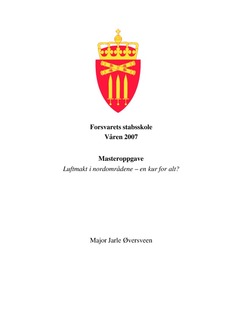| dc.description.abstract | Due to the potential existence of vast petroleum deposits in the Norwegian and Barents Seas, the economic and strategic significance of the High North may increase in the years to come. The natural resources have caught the attention of other states, creating a new source of possible conflict in this region.
For Norway, the exploitation of oil and natural gas represents the major foundation of the welfare state, and the Norwegian Armed Forces is given a significant role in maintaining control over the resources. The aim of this Master’s thesis is to analyze:
The use of air power in a limited conflict in the High North – possibilities and limitations.
The analysis is based on two fictitious conflict scenarios with different levels of intensities, one taking place in the area surrounding the Spitsbergen Archipelago and the other in the disputed area in the Barents Sea. The aim is to analyze how air power, using Norwegian national air assets, may contribute to conflict prevention and management, focusing on five functions: presence, situational awareness, reactivity, deterrence and escalation. In this context, presence is the key issue, creating the foundation for the remaining functions.
In principle, the Norwegian Air Force has every opportunity to contribute considerably to the effective conduct of conflict prevention and management with its highly capable and technologically advanced sensors. However, due to heavy maintenance and technological modifications, operational availability of most air assets is relatively low. Operating outside the coverage of the land based radar chain and with no common communication systems with the necessary bandwidth and range, effective command and control of the limited military assets is a difficult task. Operating far from the shore also significantly affects endurance and range, especially for the helicopters and fighter aircraft.
One of the main challenges when using military power as an integrated part of conflict negotiations is to avoid inadvertent escalation. The use of offensive fighter aircraft must therefore be given careful considerations in order to avoid unintended effects. However, in some cases decision-makers may find it necessary to use such powerful means earlier than desirable due to the lack of other available air assets, hence limiting their ability to further escalate the situation if necessary.
To a great extent, the discussion focuses on the tension between the requirement for a high level of presence in order to conduct effective conflict prevention and management, and limited resources to carry out the tasks. It also discusses the complex balance between military cacapability and political will when it comes to using military means to accomplish political aims. | en_US |
